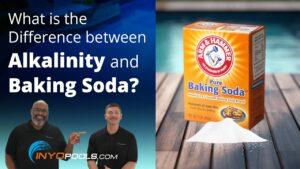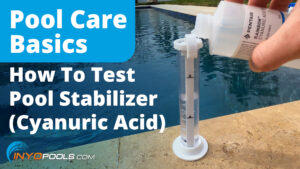In the past, the only advice we offered for extremely high CYA is to drain your pool partially. Lowering your CYA without draining your pool was unheard of, until now.
Recently, we came across an article in Aqua Magazine that details a fairly new way to lower your pool’s CYA level. Without diving too deep into the chemical side, we provide step-by-step instructions any pool owner can follow.
Lowering Your CYA Without Draining
1. Adjust Your Chemicals Levels
- pH levels to 7.0. This is critical.
- Total Alkalinity to 80-120 ppm,
- Calcium Hardness to 200-400 ppm
- Water Temperature to 70-90 degrees Fahrenheit. This is critical.
2. Clean Your Pool
Before beginning this process, ensure the pool is free of heavy debris. Large debris can stir the floc and disrupt the vacuum-to-waste process.
3. Test Your CYA Level
Don’t forget to test your CYA Level before you add any additional chemicals to your pool.

4. Prepare Your Filter
- Sand and DE Filters: With the pump off,adjust your multiport valve to the ‘recirculate’ position.
- Cartridge Filters: With the pump off, remove the filter element. Then, reassemble without it.
5. Add The Aluminum Sulfate
Next, add the aluminum sulfate to your pool at a rate of 8.33 lbs per 10,000 gallons of water. Ensure to follow the manufacturer’s directions and safety precautions on the product label.
6. Set Your Timer And Relax
Set the time clock to run your pump for two hours and then shut it off. Remove the ‘ON’ tripper from the time clock or set your automation to service. Then, set an egg timer to avoid unintentional circulation.
Allow the pump to remain off for a minimum of 12 hours. Do NOT run your pump until you completed the entire process.
7. Vacuum
With a portable vacuum cleaner, vacuum the floc to waste at a pace slow enough not to stir or ‘break’ the floc.
8. Retest Your Pool
First, test the residual aluminum levels. It should be < 0.2 ppm.
Finally, re-test your CYA levels. Overall, it is a fairly simple process to do. The pH, alkalinity, and water temp are critical. Get those three parameters set, calculate your pool volume, measure your doses, and follow the instructions.
Overall, it is a pretty cool process. The water clouds rise up, and when you come back the next day, it’s all sitting on the bottom of the pool waiting to be vacuumed.
Grab your tools and equipment, clean it up, refill, rebalance the water, and you’re done.
The Results
Plenty of people can attest that this method of lowering your CYA without draining works. Here are just two professionals who have seen good results:
“I personally have seen almost a 50% drop in CYA by adding just 8 lbs of alum per 10K of water in a little over 12 hours on a 19,000-gallon pool with a water temp of 80 degrees.”
—John Poma, A+ Pool Service, Lakeland FL.
“Alum has been our go-to when needing to quickly reduce CYA without draining water. We have dropped levels up to 10 ppm with a light dose of only 3 lbs per 10,000-gallons in one treatment.”
—Aimee Clark Olds, All N One Pools, Lafayette, LA.
https://aquamagazine.com/features/a-new-way-to-remove-cya.html?oly_enc_id=9130E2782801C7S












Leave a Reply